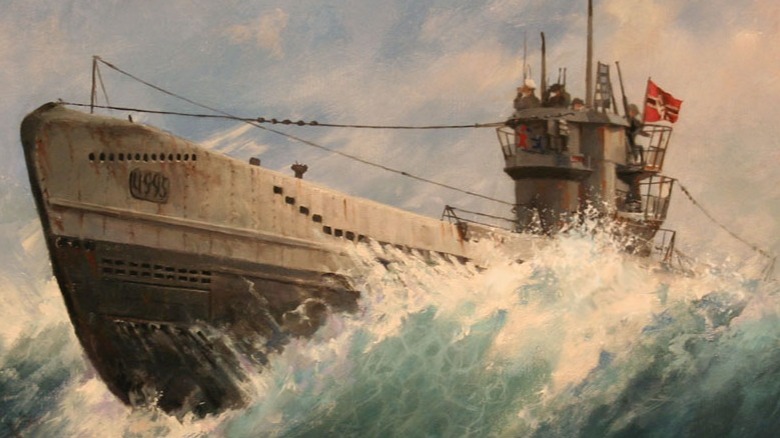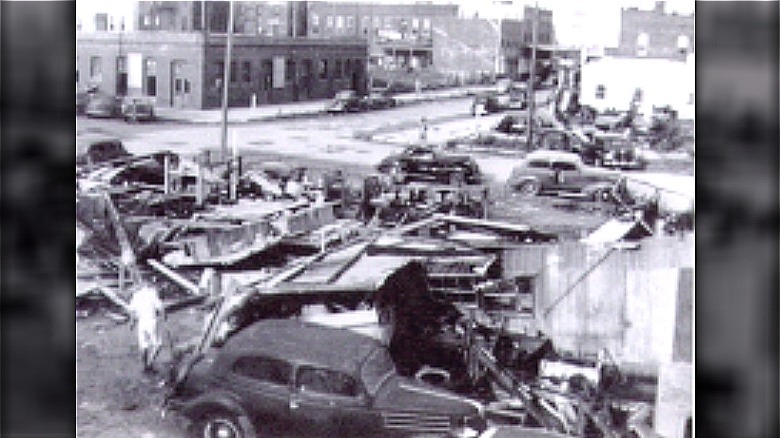The Only Time The US Government Censored A Storm
When the hurricane slammed into Galveston, Texas on the morning of July 27, 1943, it caught the city unawares. The only warning of the approaching monster storm had been a small article in the local newspaper the day before, according to the 2009 book, "The Polio Years in Texas: Battling a Terrifying Unknown." Even then, the newspaper report only indicated the possibility of a small tropical disturbance, and Houston's head meteorologist, C. E. Norquist, told the reporter not to get people riled up by calling it a hurricane, per the National Weather Service. But it was in fact a hurricane, and an incredibly dangerous one.
For two days, the surprise hurricane battered the Texas coast from Houston to Port Arthur and further east into Louisiana. In Houston, 132 mph winds ripped through the city, and in Port Arthur, 19 inches of rain drenched its residents, per Houston Public Media. By the time the storm died out, it left a trail of destruction and bodies in its wake.
Why was there no warning?
Beginning in January 1942, Nazi U-boats off the U.S. East Coast began disrupting shipping and sinking allied ships in what the Germans dubbed Operation Drumbeat, and by May, they were operating in the Gulf of Mexico with near impunity, according to Canada's Legion Magazine. In May 1942 alone, U-boats sank 115 ships of the coast, with almost half of those taking place in the gulf, per the magazine.
With U-boats patrolling the waters like so many ravenous sharks, and the addition of the oil, shipping, and munitions industries pumping out needed war supplies, the U.S. government, not surprisingly, was trying to keep any information that their enemies could use against them under wraps. That included news about the unnamed surprise hurricane that slammed into the Texas coast in the summer of 1943. At the time, meteorologists leaned heavily on weather reports from ships to help in storm predictions, but because the War Department banned shipping communications in the gulf, this vital information never made it to the National Weather Service, according to ABC13.
The death toll and damage from the surprise hurricane
In Galveston and the nearby Bolivar Peninsula, the storm, a Category 2 or possibly 3, according to Houston Public Media, leveled houses and sank ships in harbors, including a U.S. Army Corps of Engineers dredge named the Galveston. The ship, docked on the Bolivar Peninsula, became unmoored, smashed against rocks on a harbor jetty, and sank. Ten crew members out of 57 aboard were killed, according to The Tyler Morning Telegram. To the east in Port Arthur, another ship, an ocean-going tug called Titan, sank as it tried to make its way to safe harbor, killing four of its crew, per the National Weather Service. In Texas City, 90% of its buildings were either completely destroyed or suffered water damage. All told, there were 19 deaths, hundreds of injuries, and $17 million in damage, per "The Polio Years."
Across the Texas Gulf Coast, in what would end up being a devastating unintended consequence of the War Department's ban on ship-to-shore communication, oil refineries and other heavy industries vital to the war effort were damaged during the storm, damage that might have been mitigated had there been more advanced warning of the coming hurricane. This was the last time the U.S. government censored weather information, according to Houston Public Media.


